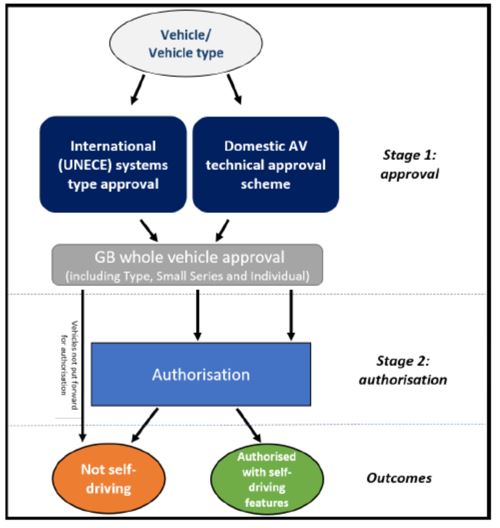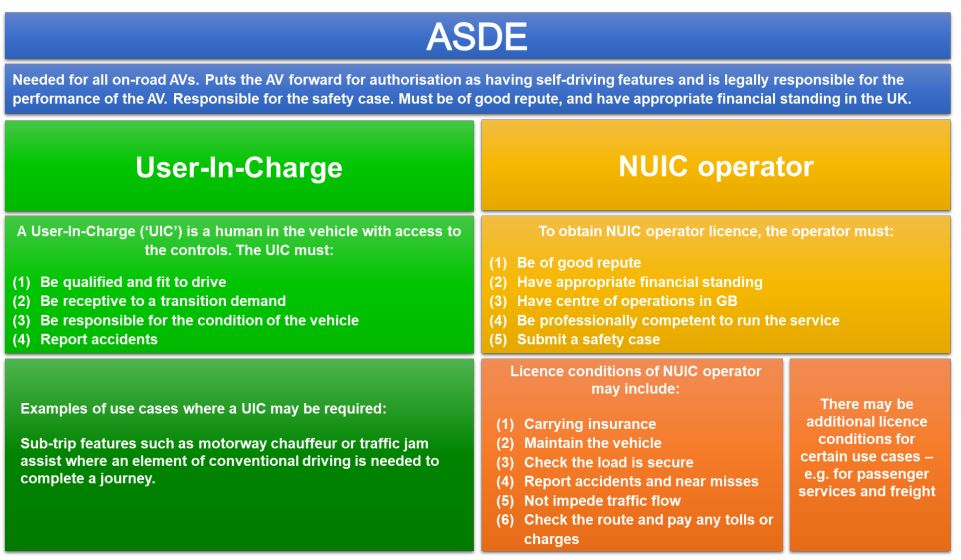The Law Commission of England and Wales and the Scottish Law Commission (the Law Commissions) have today published a joint report concluding their three year review of the legal framework for automated vehicles (the Joint Report). The Joint Report makes 75 separate recommendations including new laws to be introduced to regulate automated vehicles in Great Britain. In this first of our series of articles on the Joint Report, we provide a summary of some of the key recommendations made by the Law Commissions in respect of:
- Pre-deployment Safety Assurance – the new approval and authorisation framework for automated vehicles
- New legal actors – including the new term 'Authorised Self-Driving Entity', 'user-in-charge' and 'Non-User In Charge' entities
- Post-deployment safety and regulator
- New obligations and offences for those marketing and putting automated vehicles forward for authorisation in respect of what is said to both consumers and to regulators
Pre-deployment Safety Assurance (Approval and Authorisation)
Type approval
The Joint Report recommends that manufacturers including an automated driving system (ADS) in their vehicles should be able to choose between:
- obtaining systems approval at international level in accordance with UNECE regulation from an UNECE approval authority; or
- applying for domestic approval under a new domestic automated vehicle (AV) technical approval scheme.
Irrespective of the route chosen, the manufacturer will need to receive GB whole type vehicle approval. Once approved, an automated vehicle would still have to be authorised for use in Great Britain.
A new authorisation scheme
The Joint Report sets out the Law Commissions plans for a new authorisation scheme to determine whether an automated driving system (ADS) feature is or is not self-driving. The authorisation scheme has been developed to address the clear need for a distinction between when the user (i.e. the individual in the driving seat) is responsible for the dynamic driving task and when they are not because the ADS is self-driving. This system of authorisation is intended to facilitate or replace the system of Secretary of State for Transport ‘listing’ currently in section 1 of the Automated Vehicles and Electric Vehicles Act 2018.
A new authorisation authority will be required to administer the scheme. The authorisation authority will have a number of responsibilities:
- ensuring that each ADS feature is capable of self-driving
- specifying if each ADS feature within the vehicle, describing its operational design domain and setting out whether it can be used with or without a user-in-charge
- registering an entity as the authorised self-driving entity (ASDE) (this replaces and is not to be confused with a previously considered term of 'ADSE' or Automated Driving System Entity which is no longer in use)
The Joint Report recommends that the new Act require the Secretary of State for Transport to publish a safety standard against which the safety of automated driving can be measured. The Law Commissions’ recognise that when determining how safe an automated vehicle should be any residual risks should be acceptable to the public and that broadly speaking, automated driving should cause fewer deaths and injuries than human driving.
The new process is helpfully summarised in a diagram provided by the Law Commissions:

(Source: Joint Law Commissions, Automated Vehicles: joint report, under the Open Government Licence v3.0)
New Legal Actors
The Joint Report introduces a number of new legal actors who will have distinct responsibilities.
Authorised Self-Driving Entity
Whilst there is some flexibility on the identity of the ASDE, the Joint Report notes that the ASDE will need to demonstrate that it is closely involved in assessing the safety of the vehicle. Consequently, the Law Commissions anticipate that in the majority of circumstances, the ASDE will be the vehicle manufacturer or software developer who submits the AV for authorisation. The ASDE will have a number of obligations:
- presenting the safety case evidencing the safety of the system. The Law Commissions recommend that the safety case is signed by a senior person within the ASDE who will be subject to the duty of candour and who could face criminal sanctions if they do not exercise due diligence to ensure the information in the safety case is correct and complete
- submitting an equality impact assessment setting out how the ASDE has taken account of the needs of other vehicle and road users
- ongoing duties as a condition of authorisation including that the vehicle continues to drive in compliance with road rules, that users are aware of self-driving features and the limitations of such features
- demonstrating to regulators how data collected by the vehicle (including location data for detected collisions) will be recorded, stored, accessed and protected. The Joint Report recommends that systems should only be approved as self-driving if they comply with data protection law
Users-in-charge
The recommendations propose an overhaul to the current system of legal accountability for driving to recognise that in a vehicle where an authorised 'self-driving' ADS feature is engaged, the driver will no longer be actively engaged in the dynamic driving task. The legal framework has to date focused on the driver of the vehicle but the Law Commissions’ recommendations will adjust this focus to recognise that when an authorised 'self-driving' ADS feature is engaged, the driver will no longer be a driver of the vehicle but instead a 'user-in-charge'. As a user-in-charge, the driver will have immunity from a number of offences relating to the way the vehicle drive.
Every vehicle driving itself should have a user-in-charge unless the ADS feature is authorised for use without a user-in-charge. Under the Law Commissions’ recommendations, the user-in-charge would be an individual who is in the vehicle able to operate driving controls whilst the ADS feature is engaged and retaining a number of responsibilities in respect of both driving and non-driving related tasks.
The NUIC operator
When a 'No User-In-Charge' (NUIC) feature is engaged, the Law Commissions recommend that the vehicle is overseen by a licensed NUIC operator. This will be an organisation rather than an individual. The Joint Report notes that during engagement of a NUIC feature, the operator will need to have oversight of the vehicle and be able to respond to alerts from the vehicle.
NUICs will need to submit a safety case demonstrating how vehicles can be operated safety without a user-in-charge or driver. It will also need to demonstrate that it is of good repute, appropriate financial standing, conducts its operations within Great Britain, and is professionally competent to run the service. The system will not be too unfamiliar to public transport operators today. The Joint Report notes that in the early phases of AV deployment, the ASDE and NUIC may be the same organisations. Where this is the case, the entity may submit a single safety case to be assessed by the authorisation authority.
Again, the Law Commissions provide a helpful diagram of these new proposed entities:

(Source: Joint Law Commissions, Automated Vehicles: joint report, under the Open Government Licence v3.0)
Post-deployment safety and regulator
The Joint Report sets out recommendations for an in-use safety regulator who will be responsible for continuous regulatory oversight throughout the lifetime of AVs. The Law Commissions’ recommend that the in-use safety regulator will be responsible for:
- evaluating the safety of automated driving compared with conventional driving
- investigating road traffic infractions
- ensuring that ASDEs provide information to users, clearly and effectively
This is separate to and in addition to the Government’s current proposals for an independent Road Collision Investigation Branch which the Law Commissions suggest could also have a remit to investigate collisions involving AVs.
Duty of candour
The Law Commissions’ recognise that the safety assurance scheme proposed will be heavily reliant on the information submitted by the ASDE and NUIC operator to the regulator. Consequently, the Law Commissions’ recommend that a duty of candour should arise where:
- an ASDE submits a vehicle for authorisation
- a NUIC operator applies for a licence
- an ASDE or a NUIC responds to a request from the regulator
Furthermore, the Joint Report recommends that it should be a criminal offence to fail to provide information to the regulator or provide information that is false or misleading, where that information is relevant to the evaluation of the safety of the vehicle.
The Law Commissions also propose the senior managers should face prosecution for breaches of the duty of candour in some circumstances. They have adapted their recommendation for the definition of 'senior manager' in light of feedback received and the Joint Report now recommends that a senior manager is defined as an individual who 'plays a significant role in (1) the making of decisions about how the ASDE/NUIC operator is managed or organised, or (2) the management of the safety assurance process'. The Joint Report notes that most senior managers would only face prosecution if the offence took place with their 'consent or connivance'.
An offence for misleading marketing
Addressing a key issue within the automated vehicle sector, the Law Commissions are proposing a new criminal offence for engaging in commercial practices which use certain terms relating to self-driving in relation to driving automation technology which is not (a) authorised under the proposed authorisation scheme, and (b) designed for us on roads or in public places. Importantly, the offence extends to using such terms in a way that is likely to confuse drivers into thinking that an unauthorised vehicle does not need to be monitored when used on a public road or place.
Next steps
The Joint Report has been laid before Parliament and the Scottish Parliament. The UK, Scottish and Welsh Governments will now decide whether to accept the recommendations made by the Law Commissions and introduce legislation.
Burges Salmon provided detailed responses to each of the Law Commissions’ three consultations many of which are reflected in the Law Commissions’ summary and final report. Burges Salmon also established the Connected and Automated Mobility All Party Parliamentary Group (CAM APPG) alongside AXA UK.
If you’d like to discuss the Law Commissions’ Final Report, please contact Lucy Pegler or Brian Wong.
This article was written by Lucy Pegler and Brian Wong.